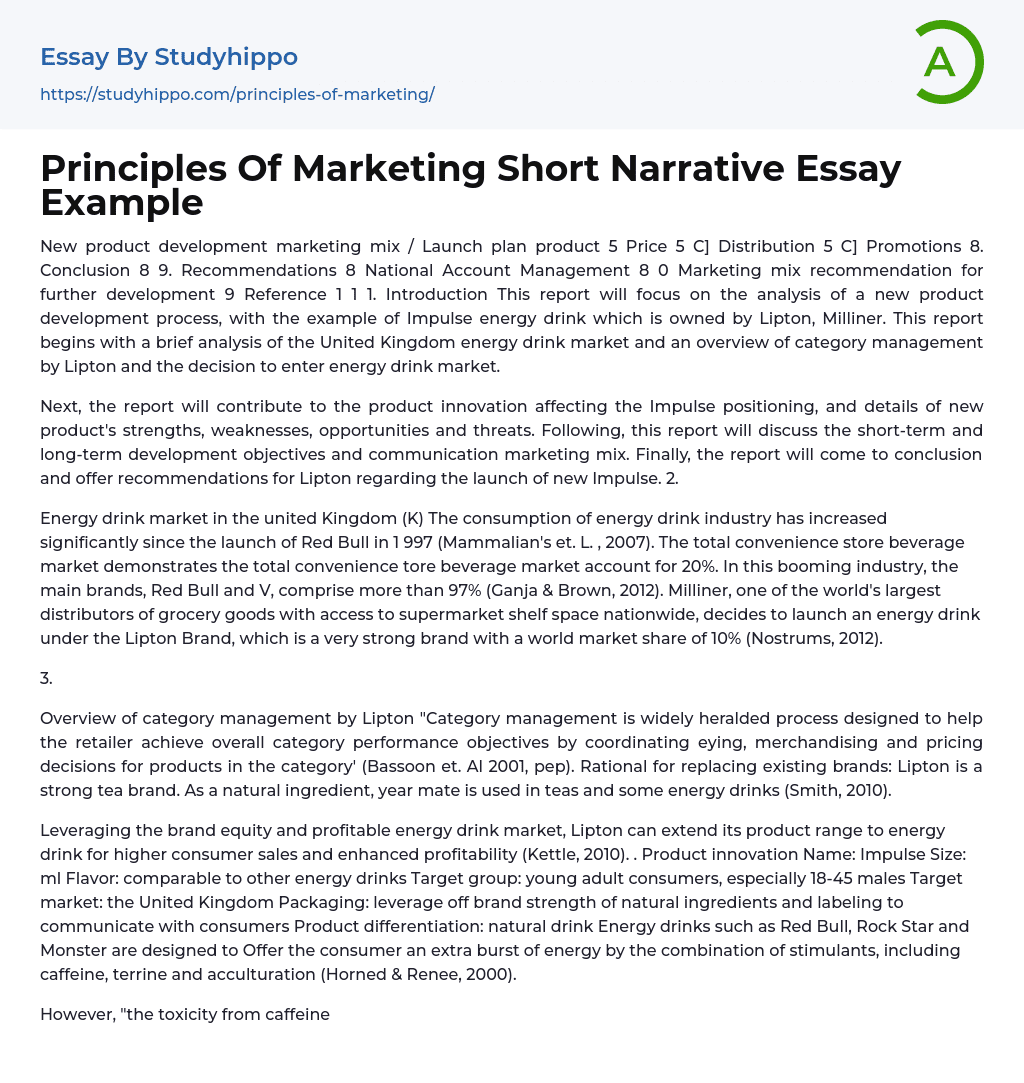This report will focus on the analysis of a new product development process, with the example of Impulse energy drink which is owned by Lipton, Milliner. This report begins with a brief analysis of the United Kingdom energy drink market and an overview of category management by Lipton and the decision to enter energy drink market.
Next, the report will contribute to the product innovation affecting the Impulse positioning, and details of new product's strengths, weaknesses, opportunities and threats. Following, this report will discuss the short-term and long-term development objectives and communication marketing mix. Finally, the report will come to conclusion and offer recommendations for Lipton regarding the launch of new Impulse.
Energy drink market in the united Kingdom (K) The consumption of energy drink industry has increased significantly since the launch of Re
...d Bull in 1 997 (Mammalian's et. L. , 2007). The total convenience store beverage market demonstrates the total convenience tore beverage market account for 20%. In this booming industry, the main brands, Red Bull and V, comprise more than 97% (Ganja & Brown, 2012). Milliner, one of the world's largest distributors of grocery goods with access to supermarket shelf space nationwide, decides to launch an energy drink under the Lipton Brand, which is a very strong brand with a world market share of 10% (Nostrums, 2012).
Overview of category management by Lipton "Category management is widely heralded process designed to help the retailer achieve overall category performance objectives by coordinating eying, merchandising and pricing decisions for products in the category' (Bassoon et. Al 2001, pep). Rational for replacing existing brands: Lipton is a strong tea brand. As a natural ingredient, yea
mate is used in teas and some energy drinks (Smith, 2010).
Leveraging the brand equity and profitable energy drink market, Lipton can extend its product range to energy drink for higher consumer sales and enhanced profitability (Kettle, 2010). . Product innovation Name: Impulse Size: ml Flavor: comparable to other energy drinks Target group: young adult consumers, especially 18-45 males Target market: the United Kingdom Packaging: leverage off brand strength of natural ingredients and labeling to communicate with consumers Product differentiation: natural drink Energy drinks such as Red Bull, Rock Star and Monster are designed to Offer the consumer an extra burst of energy by the combination of stimulants, including caffeine, terrine and acculturation (Horned & Renee, 2000).
However, "the toxicity from caffeine overdose is being reported to hospitals and poisons centers" (Ganja & Brown, 2012, pep). The healthy issue is concerned by the consumers. Accordingly, adopting year mate and no affine, Impulse would be advertised as a healthy drink, which is a point of difference (POD).
"Has a better understanding of the market, proven to be essential for profit growth Has extensive resources which reduce the relative cost and risk of new product development Established brand names can be used to rant legitimacy to new emerging markets" Jackson et. Al. 2000, IPPP) Strong market association to natural ingredients.Impulse is a new entrant into energy drink Limited product portfolio for flavors and packaging No sugar free option to address health concerns of the market (Finnegan, 2003)
The major energy drinkers are the youth who are willing to try new products so they are easily reached by marketing strategies Drinking energy drink is a defining trend for modern youth culture
Leverage off the existing brand personality, including the natural ingredients, which can be used to fraternity Impulse against competitors in energy drink category (Liana & Lee, 2010).
The reads New entrants into Fast Moving Consumer Goods (FMC) sector which exists fierce competition: Leading brands such as Red Bull, Monster and Rock Star Start-up businesses like Cocaine and Hemp. They have financial support by multinational companies which are hoping to access the growing energy drink market (The Communications Council, 2009) Indirect competitors come from other non-energy beverage companies such as Pepsi and Struck coffee as consumers may consider them as alternate.
Potential political intervention to increase controls on energy drink market 6. New product development objectives Short term Set up Impulse and link to product category, ensuring the brand grows in parallel with the energy drink category See a marketing mix that communicates to the target segments which purposively different from other competitors.
- Wal-Mart essays
- Discover essays
- Advertisement essays
- Advertising essays
- Anheuser-busch essays
- Audience Theory essays
- Brand essays
- Brands essays
- Competitor Analysis essays
- Consumer essays
- Detergent essays
- Marketing Management essays
- Marketing Mix essays
- Marketing Plan essays
- Marketing Research essays
- Marketing Strategy essays
- New Product Development essays
- Point Of Sale essays
- Price essays
- Procurement essays
- Product essays
- Product Differentiation essays
- Product Placement essays
- Promotion essays
- Promotion And Marketing Communications essays
- Research Design essays
- Retailing essays
- Trademark essays
- Anorexia essays
- Breakfast essays
- Caffeine essays
- Chewing gum essays
- Child Development essays
- Chocolate essays
- Diet essays
- Dieting essays
- Eating essays
- Eating Habits essays
- Energy Drink essays
- Food essays
- Genetically Modified Food essays
- Genetically Modified Organisms essays
- Junk Food essays
- Metabolism essays
- Milk essays
- vegetarian essays
- Vitamin essays
- Weight Loss essays
- Attitude essays
- Goals essays




